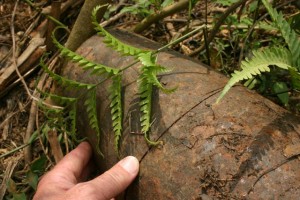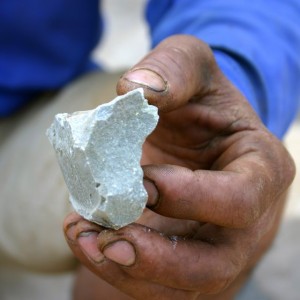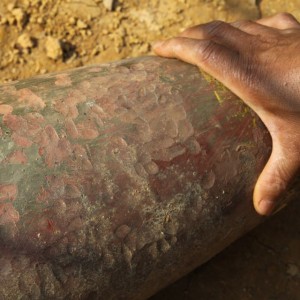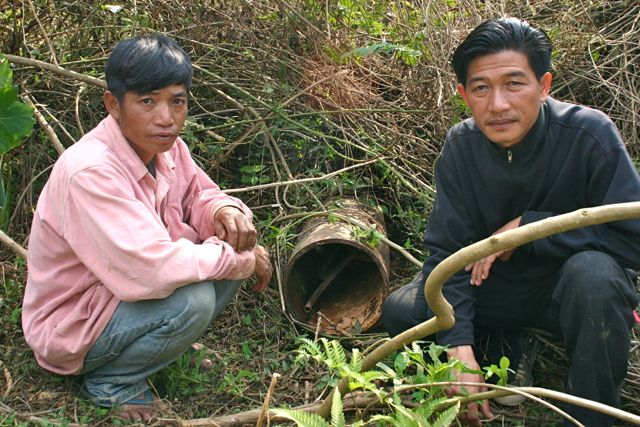Project Phongsali 2011: Of necessity, villagers turn to local experts who make bombs safe (and sometimes turn a profit.)
Day Forty-Two
Throughout Laos, in districts contaminated with UXO, just about every village has a resident bomb expert. It’s not an official position sanctioned by government; there’s no license required, no formal apprenticeship. It’s a distinction conferred by public approbation based upon observed deeds. Like membership on the US Supreme Court, the position carries the possibility of lifetime tenure but, unlike our high court justices, village bomb experts rarely outlive their faculties.
Rarely are the experts entirely self-trained. Working with bombs, you can learn a great deal through personal experience, but only from successes; learning by “trial and error” can leave an aspiring bomb maven with scant opportunity to contemplate a mistake.

The saw marks on this bomb indicate a false start. Had the people who started sawing on this bomb continued, their saw would have hit the bomb's booster. Someone must have intervened and shown the workers a better place to cut.
(Sorry if “guys” sounds sexist but, every village bomb expert I’ve ever met has been a male. Unlike “sperm donor”, an exclusively male occupation, there’s no reason why women can’t be village bomb experts; I’m certain that women have the inherent capacity to match or exceed the performance of men. Someday, in some Lao village, a female will earn the distinction. But… until then, out of a lazy desire to simplify my narrative, I’ll continue to refer to the village experts collectively as “the guys”).
The local experts frequently help their neighbors solve problems with the UXO found in gardens and rice fields, along footpaths and forest trails. They usually know which items can be moved and which cannot, what can be recycled and what must never be tampered with. Since Phongsali has lived since war’s end without ordnance removal from either a government agency or aid organization, the local experts have been sole providers of an essential public service.
But… most of the time the guys are in it for the money.
Sometimes they hire themselves out. I recently met a man who charges 500,000 kip (approximately US $65) to open a bomb. Once he’s opened the casing and collected his fee, the bomb’s owner takes over and conducts the laborious (and still life-threatening) job of chipping out the explosive. This fellow told me that over the years he’s fiddled his way into at least thirty bombs, sometimes sawing, sometimes hammering, sometimes wrenching off bolts. Whatever it takes.
While the sale of scrap metal is one inducement to tamper, it’s the sale of explosives that tips the risk/reward scale. An empty 500-pound bomb casing weighs approximately 250 pounds and might have a scrap value of thirty to forty dollars. In contrast, that size bomb contains 250 pounds of explosive with a current black market value of at least two dollars per pound, making the contents far more valuable than the casing.

Approximately half the weight of a general purpose bomb is in the casing. The remaining half consists of high explosive. Some villagers risk their lives chipping the rock hard material from the casing to sell at the black market rate of about two dollars per pound.
The explosive inside the American bombs that we find has the color and texture of limestone and is, in fact, rock hard. Originally, back in the bomb factory, the explosive was poured into the casing, as slurry. Over time, the semi-liquid material solidified and hardened.
To remove explosive from a forty-year-old bomb, harvesters must chip it out with a hammer and chisel. As workers dig deeper into the casing, the task becomes more difficult. Ultimately, the last remnant of explosive will be out of arm’s reach and precariously close to bomb parts (the booster and fuses) that could explode if struck.
(In an earlier post, I wrote about two teenagers in Khammouan Province who were killed when they struck a bomb’s booster with a trowel. See our August 27, 2008 blog: “Everyone knows that some kids will die collecting scrap”)

Someone hammered on this bomb repeatedly in order to fracture the explosive inside the casing. Because this bomb didn't explode, that person may think that hammering is a safe technique to use on the next bomb.
One unsolved mystery: where does all the harvested explosive end up? People say that villagers use the explosive to make fishing bombs, or for farm work like blowing stumps out of the ground. But, the amount of explosive available here far exceeds local needs. For instance, a single 750-pound bomb contains enough explosive to make over 4,000 fishing bombs. Stumps out of the ground? Boulders out of the roadway? Same story: far more explosive on the black market than is needed locally.
More likely, thousands of pounds of explosive are moving through black market channels to destinations distant from Phongsali, perhaps to neighboring countries such as Thailand and Burma– places with disaffected populations who might desire the wherewithal to make a loud political statement.

